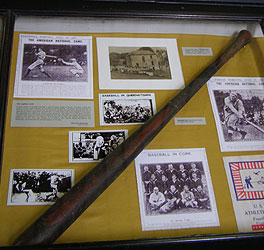
Pull Together
The U.S. Navy in Queenstown 1917/1918
On 6th April 1917 America joined with the Allies in the war against Germany. German submarines had sunk many ships since the outbreak of World War I including RMS Lusitania on her voyage from New York to Liverpool resulting in the death of many American citizens.
There were unauthorised German submarines along the US East Coast. Germany's declaration of unrestricted submarine warfare in the spring of 1917 provided the final decision for America to enter the war at its most critical stage.

Case of naval items
On 24th April six destroyers of the USN Eighth Division sailed under sealed orders from Boston. Their Commander was J.K. Taussig whose flagship was the USS Wadsworth. Their destination was Cork Harbour to join the British units already based there. On 4th May they were escorted by HMS Mary Rose to the naval anchorage off Haulbowline.
A total of 92 American ships were stationed in Cork Harbour during the last two years of the war.
In defending the western approaches to Ireland, Britain and France the destroyers had three specific missions: to destroy enemy submarines, to protect and escort merchant vessels and to save the crew and passengers of torpedoed ships.
In command of the British Navy in Queenstown at that time was Vice Admiral Sir Lewis Bayly, RN. Rear Admiral Sims, USN was sent to take command of the US Naval Force. Both were based at Admiralty House in Queenstown.
The two admirals had a high regard for one another. Much of the success of the campaign was attributed to their ability to work together and to the co-operation of their officers and men.
At the close of hostilities the American commanding officers in the port presented Admiral Bayly with a silver half model of one of their destroyers. They named it USS Pull Together as a token of the spirit of unity which had existed between the two navies.
